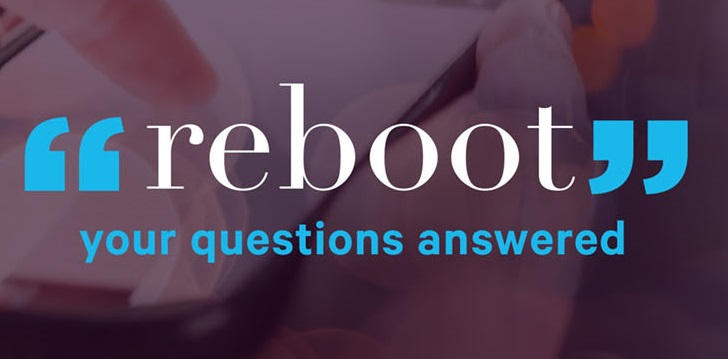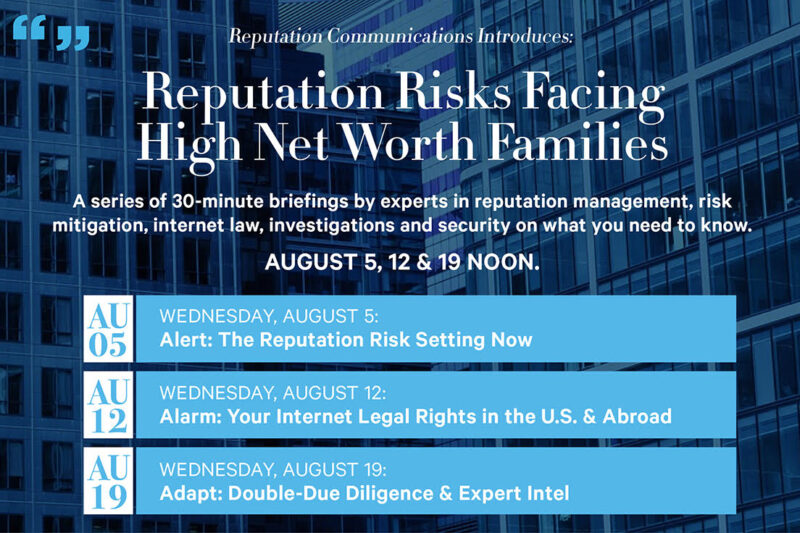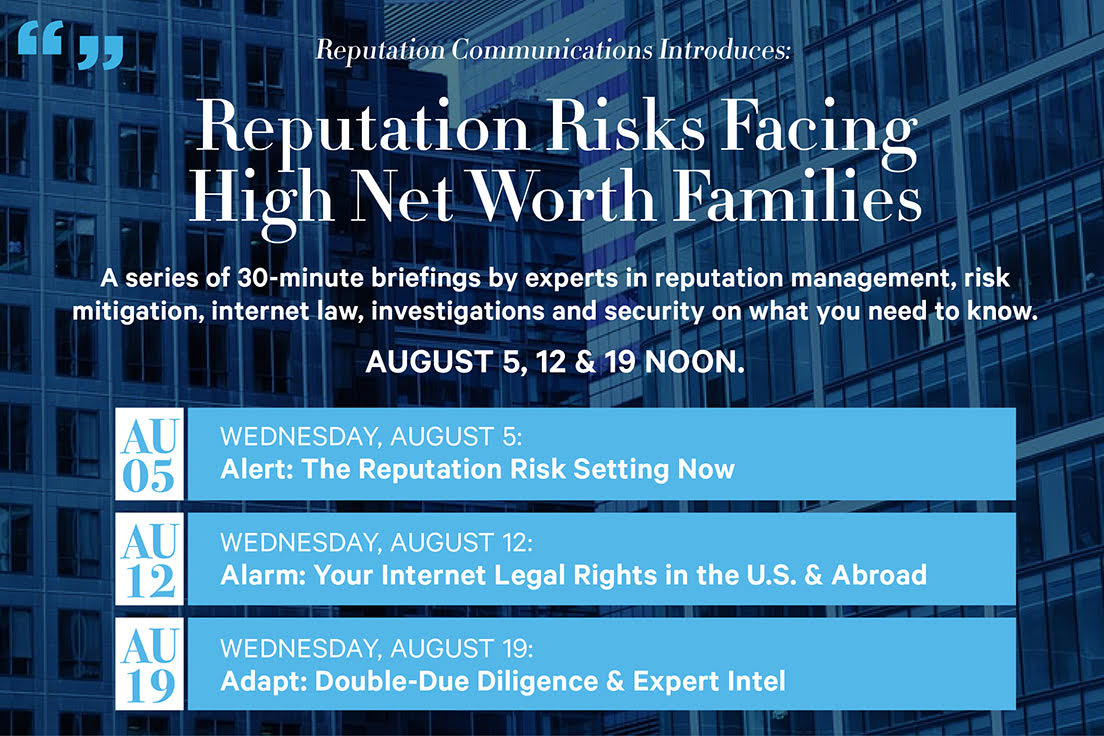
Online reputation management (ORM) makes you look your best online. It creates a “digital firewall” to protect your reputation from harmful attacks or misinformation; ensures your public image is accurate, up-to-date and authentic, and is the ultimate personal branding tool. Here is what you need to know, based on our work with high profile, often high net worth clients…as well as CEOs, C-Suite executives, entrepreneurs, investment firms, philanthropists, Silicon Valley tech founders and countless others.
We share our insights, tools and industry intel here to help the greater public understand how ORM works, what to do when you need it, and how to implement your own personal reputation management campaign.
How Google Impacts Your Online Reputation
One of the most asked questions online reputation management (ORM) firms receive is, Why is this outdated/irrelevant/negative/false content still showing up in my Google search results?
The online reputation management industry exists to strategize and publish content on Google that will shape its search results. Before we get into how online reputation management works, it merits some initial insights about what Google seeks.
Ultimately, Google’s goal is to provide visitors with the most relevant and reliable information about every topic that is searched for.
So, sites that have the most comprehensive and well-written information, have the highest number of visitors, and are linked to the most legitimate and high-ranking websites, are the ones that come up the highest and fastest in Google searches.
This is especially true now, as Google’s algorithm increasingly utilizes AI (artificial intelligence) to determine what search results to rank highly. We blogged about this: Big Changes to Google’s Search Results. Equally notable is Microsoft’s growing ambition to take a bigger piece of Google’s business, which we wrote about here: Microsoft Signals a New Era for ‘Search’ Online. Bottom line: Clunky, poorly written content with SEO-centered tricks are out the window.
What hasn’t changed is that Wikipedia and LinkedIn entries are usually the first to come up in someone’s results, at least on Google. A personal branding website (yourname.com) is next, or in the top results. Social media accounts, if used often, frequently appear on the first page.
Media articles or legal notices on government websites, no matter how old, often dominate your search results because they meet Google’s criteria for credibility and relevance more than any other information on the Internet. They can be displaced through frequent “refreshes” of newly published social content, website updates and authoritative content that links to the information online you own or manage. Using the latest technology for your websites and content is also important, because Google vets how fast sites download on mobile phones, which can influence their rank in the algorithm.
Google currently accounts for 86% of the global search market, so it is to your advantage to understand Google’s algorithm and how search engine optimization (SEO) works to improve the quality and quantity of website traffic to a website or a web page from search engines. Google publishes considerable, free information about this topic. It also keeps the world informed every time it makes a change to its algorithm via the Twitter site, Google Search Central (@googlesearchc). MOZ, a leading platform for SEO specialists, publishes an extensive free guide for anyone wanting to learn the workings of SEO, as well as free tools for assessing a site’s SEO and subscription tools for ramping up SEO. There are a myriad of other resources, including SEMrush and Search Engine Journal.
Know that managing the online content about you and curating your personal and professional brand to ensure it is the most relevant and reliable data available about you will go a long way in shaping how the world perceives you online.
What is Online Reputation Management?
Our post, “10 Ways Online Reputation Management is Used,” illustrates its most common applications. Contrary to popular opinion, though, ORM is not a magic wand that removes unwanted information from the Internet – at least, not in the U.S., the market this article focuses on. (Typically, content can be removed when it does not meet the website’s “terms of use.” Defamatory anonymous comments are one example of such content.)
ORM involves placing new content online that pushes old or unwanted content lower in search results. It can also raise other online content higher to displace unwanted material. Once successfully arranged, the results must be maintained. Otherwise, the unwanted material may resurface at the top of Google search results — usually within three to six months.
New content does not automatically appear at the top of search results. The key challenge of ORM is to create content that search engines will rank highly. That involves an understanding of search engine algorithms as well as, increasingly, the ability to create high-quality content. The best ORM uses strategies that Google considers “white hat,” which is described in the SEO section below. (This article by our CEO sheds more light on effective ORM tactics…and ones to avoid.)
ORM is an unregulated industry. Educating yourself about it and ensuring a provider is above-board will protect you from fraudulent practices. Blackmail and extortion are just two examples used by unsavory vendors. False promises also abound. Before you hire an ORM firm, educate yourself about this field.
This YouTube interview with our founder and CEO, Shannon Wilkinson, provides insight into how online reputation management works. Conducted by The Beverly Hills Bar Association, it focuses on reputation management for attorneys and law firms, but the principles apply to any type of professional or organization.
Managing your digital footprint
ORM consists of monitoring, improving and maintaining the publicly available online information about individuals, businesses and organizations. (We also describe it is as “managing your digital footprint.”) ORM began in the mid-‘90s, in response to the proliferation of online social media and the opportunities for anonymous commentary to be made about anyone—and for that commentary to remain online forever.
ORM helps you create and maintain an appropriate online image so that any attacks on your image are counterbalanced with more credible, factual information. It helps remove personal addresses and other data from public databases, also known as “people search” databases. It protects your online brand from being taken over and misused by third-parties. There are also specialized services that help businesses to track and manage their consumer reviews.
Since the European Union passed the Google “Right to be Forgotten” law, many U.S. citizens have taken a renewed interest in trying to have their own content removed from the Internet. Our tips for becoming an informed consumer regarding your removal options are featured in this post: How Google’s Content Removal Request Process Works.
To learn more about the growing power of future “Right to Be Forgotten” laws, read this interview: “Dan Shefet: Creator of the Internet’s Ombudsman.”
Management, repair and monitoring
Managing the information that is publicly available online about you or your organization allows you to “take ownership” of your reputation. When you don’t take an active role in determining what biographical and professional information about you appears online, others may make that decision for you. “Others” include automatic programs (“bots”) that continuously collect and index publicly available information online. Many focus on personal data, which can include your age, home address and family members’ names.
That’s why it’s important to take the first step of knowing what information about you exists online. You can’t control what people say about you in articles, blogs and online forums. But you do have control over such items as professional biographies, company profiles (often compiled by sources other than your place of employment) and other types of content.
The more you contribute to the body of information about you that is online, the more you can supplant inaccurate and unwanted information that may surface about you (or someone with the same name). Having a significant body of factual information about you online also ensures you have a presence in the wider community. It helps protect you from identity theft, as security expert Marc Goodman explains in his book, “Future Crimes.” You can use it as a tool to present a more mature image of yourself as well as to help prevent age discrimination during a job search.
Why is Online Reputation Management Necessary?
Online reputation management is necessary because anyone can say anything online — anonymously, posing as an expert or as someone else. As mentioned before, bots also continuously locate and publish any data they locate from public records found on the Internet — including telephone directories and real estate ownership records filed at county courthouses. (An example of the type of harassment that is routinely conducted online is provided in this article: Online Harassment Leads to Jail Sentence. Our interview with Arun G. Rao, provides insight into the types of harassment that companies and high-visible public figures face.)
The engineers who developed the Internet in the late ’60s and early ’70s didn’t foresee millions of people would be online now. As Internet use evolved, no mandatory laws or universal systems were enstated to authenticate credentials and identify Internet users.
Few laws are in place to regulate or address what is said and posted online. Currently, website operators have legal immunity over what is said and posted on their sites. That means they are not held responsible for it in a court of law (except, generally, in cases that constitute defamation).
Why? Because of the Communications Decency Act of 1996, a law regulating Internet content that has not been updated to meet the tremendous proliferation of online usage and proliferation of social media platforms.
According to Section 230 of the Act, “No provider or user of an interactive computer service shall be treated as the publisher or speaker of any information provided by another information content provider.”
Reputational Diligence in the Digital Economy, published by RANE (Risk Assessment Network + Exchange), provides additional insight into why it is necessary. Our founder and CEO’s article on Medium conveys even more insight: The Case for Bringing the Right to be Forgotten to America.
Scrubbing Your Personal Info from the Internet, by Reputation Communications Advisory Board member Don Aviv, explains how people-search databases work and why they are dangerous. If you have been wondering how to remove all those listings advertising your home address (with photographs and value), look no more.
How Can I Fix Old or Incorrect Online Information About Me?
If the information is abusive or violates the law you can contact Google to submit a legal removal request. (Before doing so, it is best to check Google’s Program Policies to see if the material is considered inappropriate.) A positive development reported in June, 2021, is that Google plans to remove slanderous information about people published online and to also lower the types of extortion sites that often publish it. Our blog post has more info: Google Plans to Suppress Slander for Victims of Online Attacks.
Otherwise, much depends on where it is located and how it originated. There are many online information platforms that exist to aggregate and republish information. Some allow users to access their profile, so you can edit and update information about you on those sites. Other platforms make that process much more difficult. Public databases like Intelius collect home addresses, ages, family members’ names and other information that they publish in profiles that are accessible to virtually anyone.
Blogs often will correct information that is inaccurate (the name of your company, your title or position, etc), if you contact them in a neutral, reasonable manner – the way you would a newspaper editor.
If the information is on other platforms, such as an online gossip site, you have little control over it short of legal action (if you have grounds for an online defamation suit). In many cases, any request you email to the website administrator can be ignored, declined or posted online, as these actions are compliant under the U.S. government’s Communications Decency Act.
The expungement, or erasure, of public records from news providers and other resources is an issue of growing debate.
As noted before, creating your own online image – with information that accurately profiles your career, business and other relevant endeavors – is the best strategy for counteracting and possibly replacing inaccurate online information. LinkedIn is a useful tool to begin building such an image. Publishing articles and posts on your LinkedIn profile will help it rise high online.
How Can I Learn the Identity of an Anonymous Poster?
When any computer connects to the Internet it is assigned a unique code of numbers called an IP address. Computers connect to the Internet through Internet Service Providers (ISPs), which register the IP addresses of users.
Identifying anonymous posters can be difficult, especially if they are hiding their identity. (They can accomplish that by using Tor, a free tool that conceals IP addresses.) While logs collected by the blog host might correlate posts to a particular IP address, the address may not necessarily reveal the poster with any level of certainty. Difficulties may arise from public network use, dynamic IP address assignment, access from private networks that translate addresses, or through the use of internet proxies which are used to “sanitize” identities. If the blog is maintained in a public forum the only way to access log information is through legal action.
Legal action can result in a court order and subpoena for an ISP to identify the IP address. Law enforcement agencies such as the FBI and police departments around the country obtain IP identification every day.
The field of forensic cyber investigations is also a growing one. Such investigators often succeed in identifying anonymous posters and emailers through their IP addresses…going so far as to locate the users’ home addresses and other identifying information.
If you are a celebrity, public or high net worth figure and you are the focus of cyberstalking or similar serious threats online, our interview with Philip Grindell, “the online security guard,” provides important information and potential resources: Philip Grindell, Protecting Clients from Harm on Social Media and the Dark Web.
How Scores of Reputations Were Intentionally Destroyed, provides insight into how people maliciously use the internet to defame others. The lengths it can take to identify them are eye-opening.
Can I Sue to Have Online Commentary About Me Removed?
Online defamation lawsuits constitute a growing area in legal practice. If something posted about a person is deemed by a court to be a false and unprivileged statement of fact harmful to someone’s reputation – or, to cite recent cases, is “injurious,” interferes with one’s livelihood or possesses any number of related characteristics – the website can be required by law to remove the information and reveal the poster’s identity.
“An Attorney’s Advice for Removing Negative, Defamatory and Infringing Material from the Internet,” by Christine Rafin, Esq., provides insight into what is possible. (Her companion piece, ““Legal Options When Battling Online Copyright Infringement”, is also helpful.) “What to Do When You Are the Victim of Online Defamation”, provides additional overviews of your options.
People who have successfully sued in response to online defamation (typically a series of anonymous posts about them) have been awarded millions of dollars in damages. The posters identities have become public, often in the news media.
It is not always possible to have anonymous comments about you removed from an online forum or other platform—but it can be done, especially if the material is clearly defamatory. Fortunately, in 2013 many websites began revising their comment and user policies to prevent libel…and to contribute to a more civil Internet. (The more obscure and independent a site, the less likely it is that they have such practices in place. See our safe browsing tips below.) If you are the topic of such content, look for their user policy. Often they will not only remove the offensive material when requested to do so, but they will block the user who posted it from their site.
You can also support Right2Remove, which advocates for “Right to Remove” privacy policy legislation “that allows for the removal of content from Internet platforms that is designed to cause reputational harm to consumers in the United States.” Their vision is for Congress to introduce a “Right to Remove” bill that can be enforced by the Federal Trade Commission or an independent review panel.
Tips for Safely Browsing the Internet
Be cautious of visiting obscure sites with potentially defamatory or invasive content about you or your organization. All sites are full of tracking mechanisms that capture your computer’s IP address (unless you use TOR) as well as your geographical location and other data. There are also programs that can collect your email address when you visit a site – even if you have not provided it. However, the obscure sites in particular are more likely to have malware that can infect your computer. Tread with care.
Use caution when sending emails, too. Don’t say anything you would not want published on the front page of a major newspaper (or online platform). Look into encrypted services like Wickr, which is free. It is a favorite of many top privacy and cyber security experts.
The Electronic Frontier Foundation’s online defamation law guide for bloggers includes helpful general information on this topic.
Can I Have an Online Photograph of Me Removed or Replaced?
In June 2014, good news was announced for victims of “revenge porn.” Google announced it would be removing links to revenge porn websites. Since then, many states in the U.S. have enacted laws protecting victims. Lawyers like Carrie Goldberg began specializing in the new area of cyber harassment and revenge.
Elsewhere, the open culture of the Internet – where it is common for bloggers to be transparent about editing errors they have corrected and post disclaimers if they write about a company they have worked for or accepted product samples from – helps explain why it can be so hard to have a photograph (or anything else) removed. Doing so without a publicly posted explanation would be considered unethical by many online publishers and writers. Wikipedia is a good example of this system. Whenever a fact is changed, removed or replaced, it is accompanied by an explanation of who edited it and why the edit was made.
So not only is your request likely to be declined, it is possible it may be published on the site, drawing more attention to the image and making you the target of other sites that will post the image. In any case, the longer a photograph stays online, the more it is cached (stored) by other sites and gains prominence in search engines.
The best option is to post your own photographs online – the images you believe represent you and your organization best and most authentically – and take action to ensure they take precedence over other images of you in search engine results. You can do this by publishing a different photograph in as many appropriate social media profiles as possible. If they are tagged, they will show up in search results, eventually dominating them.
If you are on Facebook, make sure your Facebook privacy controls are up to date. They are constantly evolving.
Family Office Privacy Issues & Reputation Damage
Family offices — privately held companies that handle investment management and wealth management for wealthy families — face special reputation management challenges.
High net worth individuals (HNWI’s) are often the subjects of articles, Internet conversations, commentary and speculation on topics ranging from their appearance and behavior to leaked internal office documents.
Most HNWI’s and those who serve them do not wish to have a high profile, whether online or off. Indeed, most prefer to be “invisible” online. Unfortunately, that is very difficult to achieve….especially in the U.S., where we have limited legal rights regarding what is said and done to us on the internet.
Data Scraping Invades Privacy
Another reason is “data scraping.” Computer “bots” continually scan the Internet and collect the personal information of people who often don’t even realize that information is available. It is scoured from public records such as online telephone directories, driver license bureaus and the local courthouses that maintain legal records of property ownership. Then it is published in one of dozens of online “people search” databases that populate the Internet. Virtually anyone can access it for free or a nominal amount of money, like $9.99.
Other examples include:
- Websites created in a family office executive’s or family member’s name, intended to denigrate, or attract inappropriate attention to you. The content on these sites can range from responses to your political views to public protests over an offices initiatives, investments, or charitable giving.
- Anonymous and biased negative commentary about you on public Internet forums.
- Caricatures and doctored photographs of you.
- Organized campaigns on Twitter and other social media platforms (also known as “disinformation campaigns”) that attack your credibility and views.
- Demeaning photographs and text on blogs or public sites posted by former spouses and partners.
Cyber harassment and stalking are particularly invasive issues. One victim was the subject of over 50 fake blogs and social media accounts defaming him, with new ones appearing as quickly as existing ones were shut down via legal action. Another HNWI was the focus of a cyberstalker who made over 2,000 changes to his Wikipedia page, all false.
Teens and Millennials can face embarrassing and frightening situations, ones they fear sharing with their parents. Common examples are the existence of their intimate photographs, or their inappropriate comments on a “private” chat room, that are used to threaten or extort them, or may just go viral. (In such cases, he or she should not wait, but turn immediately to a trusted source such as a family attorney for counsel and assistance.
Common Sources of Reputation Attacks Impacting Privacy
Current or former colleagues, employees, and/or romantic partners who, disappointed by a lack of an anticipated raise, promotion, or proposal, can (and do) deliberately publish private documents and photographs on internet forums…or doctor them to turn neutral information into false news.
Lawsuits filed by former employees can contain highly detailed descriptions of the homes and behavior of family members. Such a claim recently became public and was published on a legal website. The focus of it was the private lives of one of the wealthiest families in America.
Criminals and the mentally deranged or unstable are also the causes of reputation-based privacy exposure, especially cyberstalking.
How to Protect Yourself
If there is little information online about you that you or your representatives have placed and have control over, whatever information third parties place online will dominate search results of your name.
You can lose control over your public image if you become the focus of attacks, unfavorable media articles, lawsuits, #MeToo and other types of content that often populates the first page of HNWI’s Google results. It is far more difficult and time-consuming to regain that control than to establish it in the first place. Many of the issues we have resolved for our clients stem from exactly that situation.
Family offices can minimize the likelihood of becoming targets of such issues by creating a strategic information program and publishing it online so it establishes a safe body of content that will rank highly on the internet.
It is possible to create such a campaign while saying little about the family: publishing general information regarding philanthropic undertakings and non-controversial topics can be used in a multitude of platforms. Such information provides a “digital barrier” to protect fake news and other negative attacks from rising to the top of a Google search in your name. Without it, you have no defense against such material.
How Do I Brand Myself?
Many damaged reputations occur when people, businesses and organizations don’t manage the information available about them online – and haven’t put any general information about themselves online. When such resources aren’t established, material from public records, old articles, Facebook sites and a myriad of other sources can easily rise to the top of search engine results…and stay there. That is why branding yourself online is so important.
The American Marketing Association defines a brand as a “name, term, design, symbol, or any other feature that identifies one seller’s good or service as distinct from those of other sellers.” A brand can also apply to an individual’s career and personal interests, in a process called “personal branding,” Advice about personal branding has been circulating for decades, but it was Tom Peters’ 1997 Fast Company article “The Brand Called You” that thrust the term into mainstream usage.
Creating a personal brand is the first step in reputation management. This brand establishes a foundation for showcasing your value, differentiating you from your competitors and affirming your reputation.
Many people have built notable careers without intentionally branding themselves. At some point, however, even they may find it helpful to rebrand themselves or establish their brand on a more visible platform. Even famous people like the Koch Brothers, the wealthiest people in America, periodically undertake public relations campaigns to improve or update their image.
Don’t leave the creation of your brand to strangers
Without a current, clearly identifiable brand, you leave the interpretation of your achievements, skills and identity to other people. That interpretation will usually be based on incomplete, and sometimes inaccurate, information. Part of establishing a brand is building a strong presence online. As mentioned before, a common reason why people suffer online reputation damage is that they lack a strong “digital footprint” – a significant, informative and current body of material about them on the Internet. Without that reputation insurance, anything that anyone posts online about you (or even someone who shares your name) goes straight to the top of results and can stay there when anyone searches for your name. The more online “assets” you own, the more tools you have in hand to suppress such material. Creating them is what ORM professionals call “building a digital firewall.”
The single most important step you can take to establish, build and protect your online reputation is to register your domain name (“yourname.com”) online. Many companies provide that service, but Google Domains is the least expensive: $12 USD annually.
How do you brand yourself?
Once you have reserved your domain extension, create a website in your name. If you are an executive or other professional who is not self-employed, your options may be very limited for how you do that. For example, if you are an attorney or a financial industry professional, your organization may not wish you to promote yourself in such a way. Or, you may not want to have such a distinctive presence online. In such cases, a one-page site may be appropriate. This is an example of a microsite, which also serves as a digital business card. Here is another one. This site has more detailed information and is a good example of a personal branding site. We have created far more subtle sites for clients who work in regulated industries or would prefer to be invisible online. So it is possible.
The primary branding tools are factual information and a new photograph. After establishing a website, use them to create profiles on key online and social media platforms. Those are all digital assets, invaluable in taking ownership of your name online. If you are an expert, a blog is the most effective way to publish consistent, quality and extensive content. It will occupy a considerable amount of valuable online real estate because it can be amplified on LinkedIn, Twitter and numerous other sites. We create such content for clients who are experts but lack the time to write their own posts. We are available to help you with yours.
If there is already substantial information about you online, those steps alone are insufficient to restructure top Google results in a search of your name. But if you are not a high-profile person, they are the first actions to take. Nine times out of ten, the prospective clients who contact us lack such critical content. We have created numerous such assets for clients who lack ownership of their name online. The result has been a restructured order of Google content that appears about them…with quality content that is also authentic. We have also created effective strategies for high-profile individuals who have reams of information about them on Google, but lack control over what is said about them.
Before you brand yourself, develop your key message. After all, you are the CEO of your career (and life). How do you want to be perceived? How can you differentiate yourself from others? Our interview with expert Lynthia Romney includes helpful guidance about this topic. So does our more recent article, The Role of Personal Branding in Reputation Management.
Establish a series of benchmark goals and implement them until you have a strong, authentic brand identity. The more well-established your brand, the better your ability to build consensus, make an impact and attract opportunities.
Take care when you plan your social media content. Most companies are now using pre-employment screening services that vet all of your Facebook, Twitter, Instagram and other social media posts to see if any “red flags” come up. If they do, you might not get an offer…and you may never know the cause. Our article, Inside the Social Media Screening Industry, explains why.
As you begin to “own” your identity online you become protected from many forms of online reputation damage. This Huffington Post interview with our CEO, Shannon Wilkinson, provides additional insight: Online, Your Reputation is Everything.
For the ultimate branding strategy, write a book. (Need help? Read our interview with Petra E. Lewis: Business Ghostwriter. She works with CEOs, entrepreneurs, thought leaders, and influencers, as a ghostwriter to help them write and publish business books.) Before it is published, read: Book Publishing: Your Ultimate Brand & Reputation Builder by Jane Wesman.
Elevate Your Virtual Style Now, our interview with stylist Aliya Thomas, provides useful tips for looking your best in Zoom and other digital meetings.
Be sure to protect your brand once you have established it. Check out our post about how one attorney filed a federal complaint using the Anti-Cybersquatting law and won a permanent injunction to protect her brand after someone hijacked her name. It helps explain why protecting your brand is so important.
What are Online Reputation Management’s Main Tools?
The four main tools of ORM include content, platforms, search engine optimization (SEO) and strategy.
Content. The most effective content begins with information-rich text that is not duplicated elsewhere online. It is helpful, relevant and well written. It can be augmented with video, photographs, podcasts and most anything else that can be placed online. SEO, platforms and strategy can only take you so far without continuously updated, quality content. That is why the best ORM campaigns have a content plan at their center.
Platforms. Platforms are the online sites where content is placed: websites, blogs, micro blogs, forums, directories, news sites, Instagram, Twitter, Facebook, LinkedIn, YouTube and hundreds of other outlets.
Search engine optimization. SEO is the process of improving the visibility of a website or a web page in search engines using frequently-searched-for words, inbound links (links to the site from other sites), effective meta tags and other techniques, including the way a website is structured. Google’s Webmaster Tools is an invaluable resource with extensive (and free) best-practices guidelines to SEO.
There are two types of SEO used in ORM: “white hat” and “black hat”. White hat methods conform to search engine guidelines and do not involve deception. Black hat techniques attempt to improve rankings in ways that are disapproved of by search engines. If search engines discover sites using black hat methods, they often penalize them by removing them from search results or by dropping their search-engine ranking so low they are effectively invisible.
SEO tips and techniques fill volumes of Internet pages – far too many to share here. Most pertain to Google’s algorithm, which is constantly changing. Between 2012 and the present, Google made the most sweeping changes in its algorithm ever. Creating high-quality content that attracts visitors has long been the most important aspect of SEO. It is only getting more important as search engine algorithms evolve to better identify the best sites.
Strategy. Every online reputation is different. Managing them requires a goal, strategic plan and timetable. It is well worth the effort.
What Do I Do When the Negative Online Information About Me is True?
What to do when negative online information is accurate, or just appears to be so?
The first impulse of anyone who is the subject of negative online commentary is to get rid of it – especially if it is true. But even after multiple attempts to resolve the situation you may see it persist for months or years.
We find a content strategy is the best solution to counter significant negative information online about you or your company. Together with the right technology, SEO strategies and social media platforms, new content is the most effective tool in substantially diminishing the placement of negative online content.
But a content strategy does not alter the facts.
A content strategy very effectively counters disinformation. But it does not alter the facts. If the negative online information is true, the best approach may be to own it. To “own” a fact is to acknowledge it. Doing so makes clear that you accept responsibility and are not trying to hide the truth. It also restores your ability to participate in the argument and ultimately influence perception of those facts. If appropriate, you might indicate the steps you have taken to address the issue in a positive way or ensure it does not reoccur. How this will be done depends on of the strength and character of the online presence you have built. There are a variety of options for turning what was negative into something positive.
Case in point: this You Online blog post highlights how a 2007 FTC investigation revealed that Whole Foods CEO John Mackey anonymously attacked a competitor in online financial forums prior to making an offer to buy the company. “That led to a realization, Mackey told Paumgarten: ‘If I wanted to continue to do Whole Foods, there couldn’t be any part of my life that was secretive or hidden or that I’d be embarrassed [about] if people found out about it.’” He made transparency part of his image and continues to be CEO.
It may be best to present a new, balanced image
In many cases it may be advisable to create a new or updated online image that authentically integrates these new facts with the achievements and the goals in your professional (and personal) life. This can be expressed in many ways, on multiple platforms, to provide a balanced view…even if you don’t reference the negative issue in your new content.
If the negative material does not disappear altogether, this new online image will present audiences a far more accurate and comprehensive image of you. Without this tactic, you leave the shaping of your image to your detractors.
Keep in mind that if you are preparing to raise capital, cultivate new business partners or join a new organization in a senior role, you may be the subject of a due diligence investigation that will turn up such issues. How you have handled it may influence how you are perceived by your potential colleagues or employers.
How Can I Enhance My Reputation Using Philanthropy?
Most people – and organizations – get involved in philanthropic pursuits out of a genuine desire to use their capital to reduce suffering and injustice. But it can also be a central part of a strategy to repair their reputation.
In such cases, the first step often taken by a public relations crisis management team is to affiliate their high-profile client with a charitable cause. The ensuing donations, events and sponsorships often improve the situation. Many of the most-respected public companies maintain a longstanding involvement in philanthropic causes for the social and public relations benefits that arise from these activities.
Microfunding, grants, sponsorships, foundations and “high impact philanthropy” – the practice of making charitable contributions with the intention of maximizing social good – have all been important in shaping contemporary international society. Gifts can be in the form of time, money or the donation of a valued commodity to a community, individual or cause that needs it.
There are many opportunities to become more involved in philanthropy. The Foundation Center, the leading source of information about philanthropy worldwide, is a good starting point. 21/64 is a non-profit organization specializing in all aspects of next generation philanthropy.
What is the Best Way to Use LinkedIn as a Reputation Management Tool?
LinkedIn is best known as a professional networking resource—but it is also an important tool for ORM. Currently LinkedIn has over 175 million registered users, including executives at every Fortune 500 company, and offers its network in 19 languages.
As a top-ranked online networking platform, LinkedIn earns a high ranking from search engines for each of its pages. So, in any search made through a major engine (Google, Yahoo, etc.), relevant LinkedIn profiles will appear among the first results.
Creating a LinkedIn profile is one of the quickest and easiest ways to create highly visible content. LinkedIn features let you personalize your profile to highlight your skills, publish articles, follow influential thought leaders, and monitor who views your profile. Use them all: the more content you add to it, the higher it will rise online, creating a valuable digital asset for you. That will also contribute to your career, as this interview with top Silicon Valley talent sourcer Martha Josephson illustrates.
Most important is that you control the content in your LinkedIn profile. With it you can ensure there is a factual and readily accessible source of information about you online. That is critical if search results of your name yield little information about you or come from third-party sources or the information that appears is substantially inaccurate or out-of-date.
In 2014, LinkedIn became a major publishing platform for its users. You can publish articles there which can be read by hundreds or thousands of readers. Then you can amplify them with Twitter, Facebook and other social media tools. This is why LinkedIn is a tremendously important branding tool.
If this interests you, be sure and check out their long form publishing tool. But only if you are writing top-quality posts. If you are, participating regularly on a LinkedIn group (or starting one of your own) will increase readers of them.
Helps differentiate yourself from others with same name
LinkedIn is an excellent tool to differentiate yourself from other people that share your name. It is a commonly used and much-trusted site that aggregates the small facts people use to find you online. (If someone searches for your name and your school or current company, your LinkedIn profile should be one of the first results.) It also pairs that information with your photo. In addition to its search benefits, this feature also ensures there is a current photo of you easily accessible online and that it is a photo you have approved.
If your name is already taken by someone else on LinkedIn, e.g. “Jane Smith,” create a customized URL such as “janesmithcleveland” (if you live in Cleveland) or “janesmithesq” (if you are an attorney) to clearly establish your identity. That will often help your URL to appear above others with the same name in search results. Our founder and CEO uses this URL address to differentiate herself from other professionals with the same name: https://www.linkedin.com/in/shannonwilkinsonnyc. Instructions for customizing your URL appears in LinkedIn’s help section.
Do I Have to Use Social Media to Improve my Reputation?
Social media plays an especially important role in maintaining and growing online reputations. Professionals invest time and capital to ensure such social media platforms as Facebook, Instagram, LinkedIn and Twitter contain content appropriate to their stature and reflect both personal and professional goals. Celebrities have found social media an effective platform to promote their creative projects, support their philanthropic causes, and stay attuned to their audience. (As well as to reinvent themselves.) Using it carelessly, though, can backfire.
Nevertheless, there are many reasons why a company or organization may not be active on social media. Some do not allow employees to utilize social media.
Some companies – and people – avoid engaging social media simply because they don’t understand the social media culture. Or, they may feel that the risks inherent in social media usage by employees outweigh the potential benefits to the company’s brand and customer engagement. Others prefer to stay below the radar online for privacy reasons. They like having virtually no online profile, especially when they work in industries where privacy is important.
If you don’t feel comfortable with the idea of using social media, don’t. But don’t let your discomfort with it keep you from learning how social media works.
Be open to learning about social media
Test social media platforms by signing up on one (or more) with an alias. Attend one of the many free or nearly free courses available. Arrange a series of training sessions with a social media consultant. He or she should be able to explain the culture of social media in a way that you understand and identify the social media platforms most appropriate for supporting your marketing, message or audience-building goals.
The right consultant can explain why and how such a presence can (or shouldn’t) become a part of your marketing and communications plan. She can also collaborate, train and brainstorm with all levels of personnel to bring them up to speed on what they need to know about social media.
A core goal of ORM is to ensure the public has access to a current, accurate, and authentic image of an individual, company or organization. Many think a strong online presence is no more than actively protecting a reputation from slander and misinformation. That is only a small part of the picture. Information on the Internet is unregulated, so it is important to have a strong online presence with an accessible, fair representation that reflects your core values.
Social media can help you do that. At the very least, understanding how social media works will keep you current professionally. If you own or manage a company, be sure and have legal social media and bring your own device policies in place for employees. Fewer than 50% of companies do, which creates a legal quagmire for employees and their employers. If you are an employee, consider your social media strategy carefully. Read Roseanne Barr and the High Cost of Social Media Authenticity to learn more.
How Can Strategic Reputation Management Help my Career?
LinkedIn co-founder Reid Garrett Hoffman is one of Silicon Valley’s most prolific investors and has been instrumental in the launch of numerous successful tech-oriented company start-ups. His book The Start-Up of You released by Random House in February 2012, has received accolades from diverse thought leaders. Hoffman’s advice for attaining career success in this new, more uncertain, economic environment? See your career as a business and yourself as an entrepreneur who aspires to stand out from your competitors.
Reputation management has grown in importance for similar reasons. Reputation management isn’t pretending to be someone you aren’t or whitewashing your background; it means that you have taken steps to ensure the audience you care about knows who you are.
According to the Reputation Institute, reputation is the new corporate and professional currency. The business world understands what is at stake. Mainstream companies such as Toyota and MasterCard now have reputation managers. “Reputational risk” is the second biggest concern of boards of directors, surpassing regulatory issues.
Who controls your image?
If you do not purposefully shape your online image, someone else will do it for you.
Case in point: In May 2011, the Federal Trade Commission approved the services offered by Social Intelligence, which provides background checks on potential new hires by scouring social networking sites (it also monitors the online activities of current employees). This is important news for users of Facebook and other social media, especially those who do not realize the impact that their online posts can have on their career opportunities.
News headlines regularly offer examples of the dangers of reckless online communication. But, if managed properly, your online image can be a powerful tool in your personal and professional life.
Trust is a key factor in doing business and building relationships, and a degree of transparency is necessary to engender trust. Your online presence offers that transparency. That is just one benefit of establishing and maintaining a strong online reputation.
What Advice do you Have for Public Relations Professionals?
How can you help your CEO and senior management protect – and maintain – their reputations when two-thirds of the online content about them is posted by consumers, or even competitors? When anyone can create a Web site accusing the CEO of a publicly traded company of any number of questionable actions, even if all of the accusations are false? When internal emails and confidential documents are not only routinely leaked, but quoted in The New York Times?
If you work in PR, the online era – the age of forced transparency – has broadened and added complexity to your role. Helping your CEO and senior management understand the reputational issues they could face is essential to helping them prepare for and navigate this new terrain. The first step is to ensure your agency has adapted to the new fundamentals of public relations. Then, take these steps.
Develop a reputation protection checklist
Develop a reputation protection checklist to review with top management. Focus on three areas: creating, updating or expanding the online information about them; monitoring that information daily so you are aware of what is being posted about them in online forums, blogs and media; and having a crisis response plan ready to enact – including on holidays and weekends, when many online issues develop. Ensuring their personal information – including home addresses – is removed from online databases is also important.
If your company does not already have an in-house system for cultivating online dialogues with customers, assess whether it would benefit from one. When they can’t easily and immediately engage with a company’s customer support system, dissatisfied and frustrated customers will vent on third-party forums. Many subscription platforms allow a company to quickly build an online area where customers can connect with each other and company representatives to report problems, share ideas and build a sense of community.
It is far preferable to address a customer’s complaints on a forum you provide. There are few laws in place to regulate or address what is posted online. Web site operators currently have legal immunity over what is posted on their sites. That makes it difficult, if not impossible, for you to have inappropriate or inaccurate content removed from other sites, even if it is biased.
Many reputations suffer needlessly
Much damage to the online reputations of executives could have been prevented. Ideally, the first two pages of a Google, Bing, Yahoo or other search of an executive’s name will contain verified, factual information about them. When that is not the case, their vulnerability to misinformation increases.
Facebook, blogs and Twitter can be effective online reputation tools. But they are not appropriate for all executives, including those in highly regulated fields like banking, pharmaceuticals and financial services. In that case, there are many other tools you can explore with them, including a variety of publishing and information platforms. Help them realize there are many ways to establish an online presence – and that they are not necessarily living in the Stone Age if they do not have a Facebook profile.
If you are a PR consultant providing Wikipedia editing services to your clients, understand Wikipedia’s new rules for paid contributors — and follow them.
If your organization’s CEO and senior executives are high-visibility or high-net-worth individuals, be sure and read Angela Hrdlicka on Protecting CEOs, Private Citizens & VIPs: Interview with an Expert. Increasingly, such threats are impacting the private sector, affecting the reputation of brands as well as individuals.
How Can I Most Effectively Use Yelp?
Yelp was founded in 2004 with a website made “to connect people with great local businesses.” Yelp has over 33 million reviews of local businesses and over 845 million users. It has become an important tool for local businesses to keep their business in good standing with customers. Yelp reviews usually appear at the top of a search by customers seeking your type of business. (There are also many other websites dedicated to consumer reviews of every product and service imaginable.)
One challenge with online consumer review sites is that companies often cannot opt out from being listed. Anyone can comment anonymously or by assuming a fake identity. It is often impossible to tell whether a complaint or review (good or bad) is authentic. Reportedly 1 in 5 Yelp reviews are fake. That issue has made Yelp the target of quite a bit of press. According to this April 2014 Washington Post article, a Virginia court required Yelp to identify anonymous reviewers who posted bad reviews about a company they had never used.
In March 2015, “Billion Dollar Bully,” an investigative documentary on Yelp that examines the claims by business owners of extortion, review manipulation and review fabrication, was announced on Kickstarter by Prost Productions. According to news reports, Yelp’s stock valuation dropped within two days of the announcement.
Reputational impact of online comments always a concern
The reputational impact of online reviews and comments has been a concern as long as the Internet has existed.
Yelp gathers and publishes listings for businesses it finds online, just as Google My Business now does. Business owners of all types have been surprised to see their business listing posted on Yelp – and possibly on up to dozens of other sites that exist to attract clicks and visitors, hence advertising income, to their sites. In many such cases, your business information is simply a tool for them to do that.
Yelp and other review sites are under increasing scrutiny. (Avvo, the Yelp of the legal community, is one.) So are the firms that can be hired to post fake flattering reviews. Witness “Give Yourself 5 Stars? Online, It Might Cost You,” a New York Times article from September 2013.
Yelp has rules and regulations purported to filter anonymous or fake reviewers who skew overall ratings of businesses in an either overly negative or unrealistically positive light. This “filter” does not work all the time, so the question remains for business owners: how may Yelp help their business thrive when reviews come from consumers with diverse experiences and preferences? (Humor helped in this instance.)
Evaluating and addressing negative reviews
When you receive a negative review, assess who the source is (or appears to be). Determine how much validity their opinion may carry, if any. If it is clearly bogus or inappropriate, move on. Don’t acknowledge it. If the review site has a reporting system for such items, use it. Realize that readers of such sites use their own filters to evaluate the tone and credibility of reviews. They are experienced in spotting fake ones, especially those with excessive sentiment on either side of the review barometer.
Yelp claims to allow for business owners to respond to reviews, so take advantage and evaluate your response for the legitimate ones. Sometimes your best response is to engage directly. Acknowledge such reviews. Apologize if it is appropriate. Be helpful. Yelp allows for users to change their minds and review scores. You can respond publicly or privately. That provides you with options to connect with that customer and find the best way to handle each (legitimate) situation. Never use an angry or defensive tone in your response.
Yelp can be an effective way to attract and maintain customers. It allows business owners to converse online with their audience through customer care and promotion of their brand. Strategic use of Yelp may improve your business search results, maintain high customer morale, and attract new business.
Yelp publishes many resources. These case studies of how business owners have responded to bad reviews may be helpful, too. (Our interview with an expert in marketing for law firms includes valuable advice about how to respond to a critical review from a customer. It can be adapted by a range of businesses.)
To help business owners take more control over the online reviews that appear about them, a number of review management businesses have developed. They are helpful tools for businesses affected by consumer reviews. But be forewarned: if you cancel your subscription to one after you have built a strong online profile of legitimate positive reviews, they may vanish. So check the small print on your contract to know just how long you need to maintain that commitment.
At Reputation Communications, we help clients look their best online. We develop, manage and repair digital profiles; create fresh Google search results and provide public relations for the digital age. We welcome the opportunity to help you develop or update your digital brand and specialize in working with CEOs, C-Suite executives, VIPs and their organizations.











